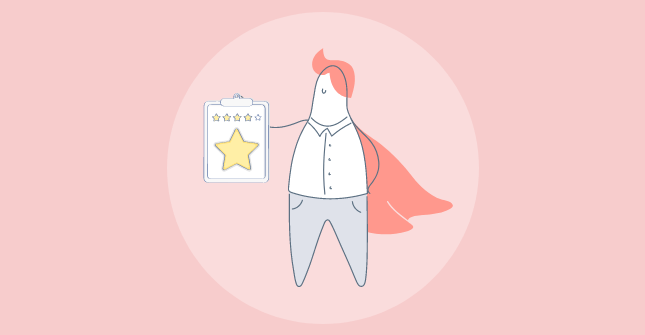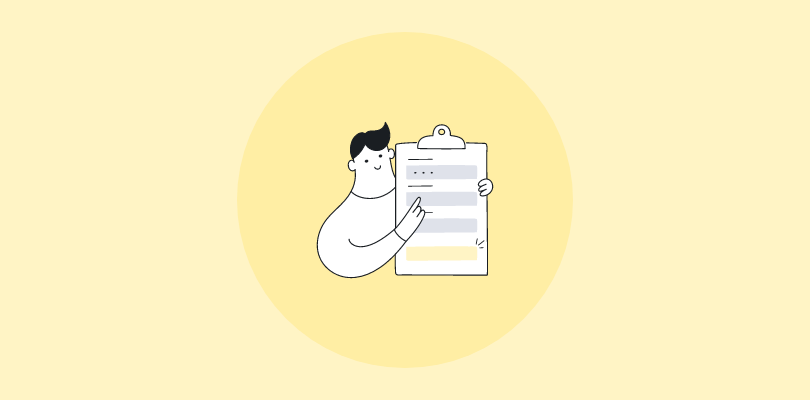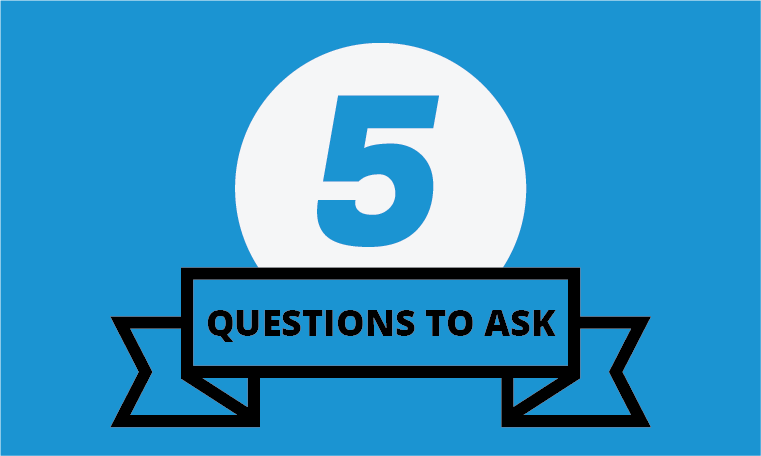Imagine that you’re at a diner holding a classic glass ketchup bottle. You just want a few tablespoons of ketchup for your burger. As you struggle with the bottle, either too little or too much ketchup comes out.

It’s easier to complain about the glass ketchup bottle than to think of a solution — a squeezable plastic bottle. Similarly, when your customers encounter a frustrating experience, it’s easier for them to complain than to think of a solution.
In order to redesign their ketchup bottle, Heinz conducted a series of focus groups and asked specific questions to their customers. For example, was the issue with the ketchup itself or the bottle’s ease of use? Did it matter whether the new bottle had clear or opaque packaging? Their customers’ feedback led to a redesigned, easy squeeze, clear plastic ketchup bottle.
In a similar way, you can get customers to give you their feedback and reveal the underlying problem through a series of crafted follow-up questions. Follow-up questions encourage customers to be more specific about their problem. Armed with this specific feedback, you’ll be guided to a solution that meets their needs.
Use branching logic to gather feedback
Follow-up questions encourage your customers to reveal the underlying reasons for their emotions. The answer to the first question might reveal that the customer had a negative experience with your product, but the follow-up question digs deeper and finds out why the customer felt like they had a bad experience.
You should use branching logic to lead customers down different paths in your survey, depending on how they answer specific questions. With branching logic, your customers only see relevant questions based on their previous answers.
 [Source]
[Source]
The feedback received from branching logic can reveal what is preventing a new visitor from becoming more engaged, what is preventing a potential customer from becoming a paying customer, and what could be preventing a paying customer from becoming a repeat customer.
Here’s how you can use branching logic in surveys to gather feedback from your customer in different stages of the shopping experience.
Use feedback to turn bounced visitor into engaged visitor
Some visitors are coming to your landing page, but leaving before they explore any further. Potential customers are also bouncing, but you don’t know why.
If visitors browse the store without buying and then leave, you want to find out why that happens. You can do this by creating an exit survey with branching logic on the product page.
You can ask something like this:
Were you able to easily find the product you were searching for?
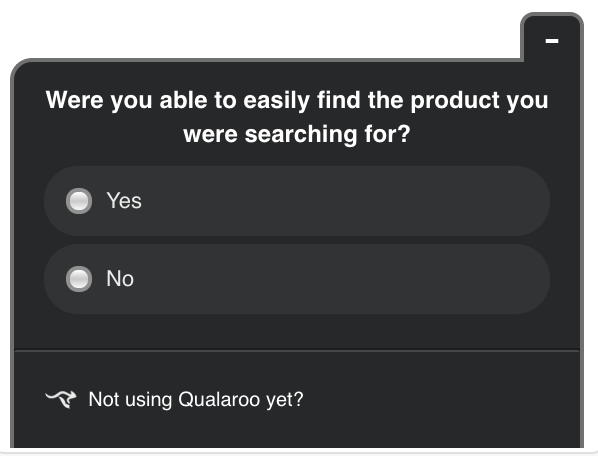
Next steps:
- If the visitor answers “Yes”, then ask: What prevented you from buying it today?
- If the visitor answers “No”, then ask: What were you looking for specifically? Please explain.
In this example, you can narrow down why visitors are bouncing. Perhaps they were able to find the product but there was some other factor (e.g. price, color, size, etc.) that caused them to leave and not add it to their cart. If the visitor was not able to find the product, then you can determine what they were searching for when they came to your site.
Use feedback to turn engaged visitor into paying customer
Engaged visitors have made it to checkout. They looked at your products, added them to the cart, but failed to purchase anything. A great way to find out why is to ask them using a cart abandonment survey. You can do this by creating an exit survey with branching logic on the cart/checkout page.
You can ask something like this:
It looks like you did not finish checking out. Is there anything preventing you from checking out?
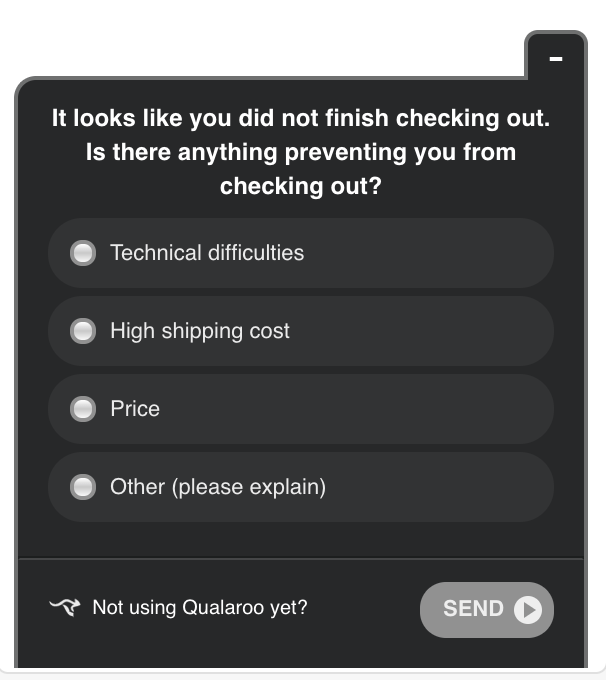
Next steps:
- If the customer answers “Technical difficulties”, then this should trigger another field for the customer to enter their contact information and provide a brief description of the problem. This contact information could then be immediately forwarded to the support team.
- If the customer answers “High shipping cost”, then a pop-up should appear with a free shipping offer if the customer completes the order now.
- If the customer answers “Price”, then a pop-up should appear with a discount or coupon code if the customer completes the order now.
- If the customer answers “Other”, then this should trigger another field for the customer to enter their contact information and provide a brief description of the problem. This contact information could then be forwarded to the support team.
In this example, you can also offer incentives to encourage your customers to complete checkout. If they answer “Price” or “High shipping cost”, you’ve given them an immediate incentive to buy right now. If they answer “Other” or “Technical difficulties,” then the support team has the needed contact information to follow up and discuss the problem with the customer.
Use feedback to turn one-time customer into repeat customer
Your customer has checked out and completed their purchase. Depending on how happy they were with the whole shopping experience, they may or may not recommend you to their friends and family. If they had a negative shopping experience, you need to know how to make it better so that they’ll shop again.
Here is an example of a customer experience survey that could be used in conjunction with branching logic. You can offer a Net Promoter Score (NPS) survey after they’ve made a purchase.
You can ask something like this:
Based on your shopping experience with us today, how likely is it that you would recommend our store to friends or family, on a scale of 1 to 10?

Next steps:
- If the customer scores between 1 and 6, then ask: How can we improve your experience to receive a higher rating?
- If the customer scores between 7 and 8, then ask: How can we be even better in the future to earn a 9 or 10?
- If the customer scores between 9 and 10, then ask: What did we do that caused you to give us a high rating?
Without follow-up questions, you would just collect a numerical rating. In this example, you can narrow down why they gave you a specific score.
For a rating of 1 to 6, a customer may reveal why they are not really thrilled with your product and offer suggested improvements for the future.
For a rating of 7 to 8, a customer may reveal what could make them even more enthusiastic about promoting your product.
If the customer gives a rating of 9 or 10, the answer to the follow-up question could be used as a positive testimonial on your site.
FREE. All Features. FOREVER!
Try our Forever FREE account with all premium features!
Let feedback guide you to the solution
Heinz used their customers’ extensive feedback to create a clear, plastic, squeezable ketchup container with a flip-top lid. This improved design made their customers much happier.
When you use surveys, let branching logic be your automated product development team, and your customers will thank you.
FREE. All Features. FOREVER!
Try our Forever FREE account with all premium features!

 We'd love your feedback!
We'd love your feedback! Thanks for your feedback!
Thanks for your feedback!



